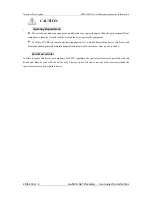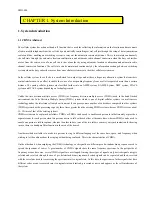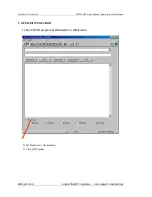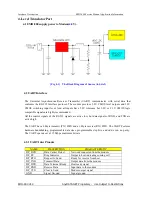
Interface Description EMII-800 Service Manual Application Information
EMII-800 V1.0 AnyDATA.NET Proprietary
Use Subject to Restrictions
3. Structure and Functions of CDMA Module
The mobile station of CDMA system is made up of a radio frequency part and logic/control (digital) part. The mobile station is
fully compatible with the existing analog FM system. The mobile station antenna is connected with the transmitter/receiver via
a duplexer filter so that it can carry out the transmit/receive function at the same time.
The transmit frequency is the 25MHz band of 824~849MHz, whereas the receive frequency is the 25MHz band of
869~894MHz. The transmit/receive frequency is separated by 45MHz. The RF signal from the antenna is converted into
intermediate frequency(IF) band by the frequency synthesizer and frequency down converter and then, passes the bandpass
SAW filter having the 1.25MHz band. IF output signals that have been filtered from spurious signal are converted into digital
signals via an analog-to-digital converters(ADC) and then, sent out respectively to 5 correlators in each CDMA de-modulator.
Of these, one is called a searcher whereas the remaining 4 are called data receiver(finger). Digitalized IF signals include a great
number of call signals that have been sent out by the adjacent cells. These signals are detected with pseudo-noise sequence (PN
Sequence). Signal to interference ratio (C/I) on signals that match the desired PN sequence are increased through this type of
correlation detection process. Then, other signals obtain processing gain by not increasing the ratio. The carrier wave of pilot
channel from the cell site most adjacently located is demodulated in order to obtain the sequence of encoded data symbols.
During the operation with one cell site, the searcher searches out multi-paths in accordance with terrain and building reflections.
On three data receivers, the most powerful four paths are allocated for the parallel tracing and receiving. Fading resistance can
be improved a great deal by obtaining the diversity combined output for de-modulation. Moreover, the searcher can be used to
determine the most powerful path from the cell sites even during the soft handoff during the two cell sites. Moreover, four data
receivers are allocated in order to carry out the de-modulation of these paths. Data output that has been demodulated change the
data string in the combined data row as in the case of original signals(deinterleaving), and then, are de-modulated by the
forward error correction decoder which uses the Viterbi algorithm.
On the other hand, mobile station user information sent out from the mobile station to the cell site pass through the digital voice
encoder via a mike. Then, they are encoded and forward errors are corrected through the use of convolution encoder. Then, the
order of code rows is changed in accordance with a certain regulation in order to remove any errors in the interleaver. Symbols
made through the above process are spread after being loaded onto PN carrier waves. At this time, PN sequence is selected by
each address designated in each call.
Signals that have been code spread as above are digital modulated (QPSK) and then, power controlled at the automatic gain
control amplifier (AGC Amp). Then, they are converted into RF band by the frequency synthesizer synchronizing these signals
to proper output frequencies.
Transmit signals obtained pass through the duplexer filter and then, are sent out to the cell site via the antenna.











































